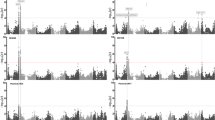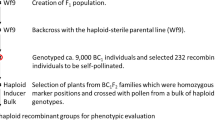Abstract
Heading date (HD) is an important agronomic trait, influencing directly or indirectly yield and quality traits. Previous experiments showed that the chromosome arm substitution line (CASL) 4AL of wild emmer in the background of Chinese Spring (CS) was about 18–22 days later in HD than CS. In this study, CASL4AL flowered roughly 20 days earlier than CS grown under long day (LD) with short day (SD) vernalization, but failed to flower when planted under controlled SD conditions. The above results suggest CASL4AL carries an extremely sensitive photoperiod response gene. CASL4AL showed a major difference from CS in restricted young spike development, remaining at the double-ridge stage and floret-primordium differentiation stage much longer than CS under SD. To map this gene, the F2 population from cross between CS and CASL4AL were explored in two consecutive years. In 2016, a HD related QTL flanked by M576 and wmc468 with a LOD score (8.5) was detected. In 2017, this QTL was repeatedly detected with a higher LOD score (10.03), and therefore named as QPpd.zafu-4A. A total of 27 genes were annotated and possible candidate was discussed. This work lays a foundation for map-based cloning of QPpd.zafu-4A and elucidating its molecular mechanism in affecting HD.




Similar content being viewed by others
References
Ahmadi H, Nazarian F (2007) The inheritance and chromosomal location of morphological traits in wild wheat, Triticum turgidum L. ssp. dicoccoides. Euphytica 158:103–108
Beales J, Turner A, Griffiths S, Snape JW, Laurie DA (2007) A pseudo-response regulator is mis-expressed in photoperiod insensitive Ppd-D1a mutant of wheat (Triticum aestivum). Theor Appl Genet 115:721–733
Bonnin I, Rousset M, Madur D, Sourdille P, Dupuits C, Brunel D, Goldringer I (2008) FT genome A and D polymorphisms are associated with the variation of earliness components in hexaploid wheat. Theor Appl Genet 116:383–394
Bullrich L, Appendino ML, Tranquilli G, Lewis S, Dubcovsky J (2002) Mapping of a thermo-sensitive earliness per se gene on Triticum monococcum chromosome 1Am. Theor Appl Genet 105:585–593
Díaz A, Zikhali M, Turner AS, Isaac P, Laurie DA (2012) Copy number variation affecting the Photoperiod-B1 and Vernalization-A1 genes is associated with altered flowering time in wheat (Triticum aestivum). PLoS ONE 7(3):e33234
Doerge RW, Churchill GA (1996) Permutation tests for multiple loci affecting a quantitative character. Genetics 142:285–294
Feldman M, Millet E, Abbo S (1994) Exploitation of wild wheat to increase yield and protein content in durum and common wheat. In: Balfourier F, Perretant MR (eds) Proceedings of European Association for research on plant breeding meeting of the genetic resources section. European Association for Plant Breeding Research (EUCARPIA), Clermont-Ferrand, pp 151–161
Ford M, Austin R, Angus W, Sage G (1981) Relationship between the responses of spring wheat genotypes to temperature and photoperiodic treatments and their performance in the field. J Agric Sci 96:623–634
Fosket DE (1994) Plant growth and development. Academic Press, San Diego
Gawroński P, Ariyadasa R, Himmelbach A, Poursarebani N, Kilian B, Stein N, Steuernagel B, Hensel G, Kumlehn J, Sehgal SK, Gill BS, Gould P, Hall A, Schnurbusch T (2014) A distorted circadian clock causes early flowering and temperature-dependent variation in spike development in the Eps-3A m mutant of einkorn wheat. Genetics 196:1253–1261
Halloran G (1975) Genotype differences in photoperiodic sensitivity and vernalization response in wheat. Ann Bot 39:845–851
Hong MJ, Kim DY, Kang SY, Kim DS, Kim JB, Seo YW (2012) Wheat F-box protein recruits proteins and regulates their abundance during wheat spike development. Mol Biol Rep 39(10):9681–9696
Kamran A, Iqbal M, Navabi A, Randhawa H, Pozniak C, Spaner D (2013) Earliness per se QTLs and their interaction with the photoperiod insensitive allele Ppd-D1a in the Cutler × AC Barrie spring wheat population. Theor Appl Genet 126:1965–1976
Kamran A, Iqbal M, Spaner D (2014) Flowering time in wheat (Triticum aestivum L.): a key factor for global adaptability. Euphytica 197:1–26
Kato K, Miura H, Sawada S (1999) Detection of an earliness per se quantitative trait locus in the proximal region of wheat chromosome 5AL. Plant Breed 118:391–394
Khlestkina EK, Giura A, Röder MS, Börner A (2009) A new gene controlling the flowering response to photoperiod in wheat. Euphytica 165:579–585
Koressaar T, Remm M (2007) Enhancements and modifications of primer design program Primer3. Bioinformatics 23(10):1289–1291
Kosambi DD (1944) The estimation of map distance from recombination values. Ann Eugen 12:172–175
Kulwal PL, Roy JK, Balyan HS (2003) QTL mapping for growth and leaf characters in bread wheat. Plant Sci 164:267–277
Li SJ, Hochstrasser M (1999) A new protease required for cell-cycle progression in yeast. Nature 398:246–251
Lin F, Xue SL, Tian DG, Li CJ, Cao Y, Zhang ZZ, Zhang CQ, Ma ZQ (2008) Mapping chromosomal regions affecting flowering time in a spring wheat RIL population. Euphytica 164:769–777
Mayer KF, Martis M, Hedley PE, Simková H, Liu H, Morris JA, Steuernagel B, Taudien S, Roessner S, Gundlach H, Kubaláková M, Suchánková P, Murat F, Felder M, Nussbaumer T, Graner A, Salse J, Endo T, Sakai H, Tanaka T, Itoh T, Sato K, Platzer M, Matsumoto T, Scholz U, Dolezel J, Waugh R, Stein N (2011) Unlocking the barley genome by chromosomal and comparative genomics. Plant Cell 23(4):1249–1263
Meng L, Li HH, Zhang LY, Wang JK (2015) QTL IciMapping: Integrated software for genetic linkage map construction and quantitative trait locus mapping in biparental populations. Crop J 3:269–283
Millet E, Rong JK, Qualset C, McGuire P, Bernard M, Sourdille P, Feldman M (2013) Production of chromosome-arm substitution lines of wild emmer in common wheat. Euphytica 190:1–17
Miralles DJ, Richards RA (2000) Responses of leaf and tiller emergence and primordium ignition in wheat and barley to interchanged photoperiod. Ann Bot 85:655–663
Murtas G, Reeves PH, Fu YF, Bancroft I, Dean C, Coupland G (2003) A nuclear protease required for flowering-time regulation in Arabidopsis reduces the abundance of SMALL UBIQUITIN-RELATED MODIFIER conjugates. Plant Cell 15:2308–2319
Nevo E, Korol AB, Beiles A, Fahima T (2002) Evolution of wild emmer and wheat improvement-population genetics, genetic resources, and genome organization of wheat’s progenitor, Triticum dicoccoides. Springer, Berlin, p 364
Pearce S, Vanzetti LS, Dubcovsky J (2013) Exogenous gibberellins induce wheat spike development under short days only in the presence of VERNALIZATION1. Plant Physiol 163(3):1433–1445
Ren X, Li CD, Cakir M, Zhang WY, Grime C, Zhang XQ, Broughton S, Sun DF, Lance R (2012) A quantitative trait locus for long photoperiod response mapped on chromosome 4H in barley. Mol Breed 30(2):1121–1130
Scarth R, Law CN (1983) The location of the photoperiod gene, Ppd2 and an additional genetic factor for ear-emergence time on chromosome 2B of wheat. Heredity 51:607–619
Song YH, Ito S, Imaizumi T (2013) Flowering time regulation: photoperiod- and temperature-sensing in leaves. Trends Plant Sci 18(10):575–583
Turner A, Beales J, Faure S, Dunford RP, Laurie DA (2005) The pseudo-response regulator Ppd-H1 provides adaptation to photoperiod in barley. Science 310:1031–1034
Wang S, Basten CJ, and Zeng ZB (2012) Windows QTL Cartographer 2.5. Department of Statistics, North Carolina State University, Raleigh, NC. https://statgen.ncsu.edu/qtlcart/WQTLCart.htm
Worland AJ (1996) The influence of flowering time genes on environmental adaptability in European wheats. Euphytica 89:49–57
Worland T, Snape JW (2001) Genetic basis of worldwide wheat varietal improvement. In: Bonjean AP, Angus WJ (eds) The world wheat book: a history of wheat breeding. Lavoisier Publishing, Paris, pp s59–100
Yan L, Fu D, Li C, Blechl A, Tranquilli G, Bonafede M, Sanchez A, Valarik M, Yasuda S, Dubcovsky J (2006) The wheat and barley vernalization gene VRN3 is an orthologue of FT. Proc Natl Acad Sci USA 103:19581–19586
Zhou W, Jiang Y, Zhang W, Xu G, Rong J (2013) Characterization of large chromosome segment introgressions from Triticum turgidum subsp. dicoccoides into bread wheat with simple repeat markers. Crop Sci 53:1555–1565
Zhou W, Wu S, Ding M, Li J, Shi Z, Wei W, Guo J, Zhang H, Jiang Y, Rong J (2016) Mapping of Ppd-B1, a major candidate gene for late heading on wild emmer chromosome Arm 2BS and assessment of its interactions with early heading QTLs on 3AL. PLoS ONE 11(2):e147377
Acknowledgements
The CASLs and their parents (CS and TDIC 140) were kindly provided by Prof. M. Feldman at Weizmann Institute of Science, Israel. This research was supported by the National Key Research Program (2016YFD0102002) to Mingquan Ding, the National Natural Science Foundation of China (31671684) to Junkang Rong, the Zhejiang Provincial Natural Science Foundation of China (LY19C060003) to Jinsheng Yu, the New Breeding Project of Zhejiang Province (2016C02050-9-9) and Public Welfare Project of Zhejiang Science and Technology Department (2014C32027) to Yurong Jiang.
Author information
Authors and Affiliations
Contributions
JSY, YZM and SQY performed the field experimentation and marker analysis in 2016 and 2017. YZM and NNM did the observation of the spike development under SD and LD conditions in the growth room. ZBS and YRJ did the field experiments of photoperiod response in 2014 and 2015. MQD analyzed the data for primer designing. HZ prepared the wheat materials for experiment. JKR and JSY wrote the paper. JKR conceived, designed, and coordinated the experiments.
Corresponding author
Ethics declarations
Conflict of interest
The authors declare that they have no conflict of interest.
Additional information
Publisher's Note
Springer Nature remains neutral with regard to jurisdictional claims in published maps and institutional affiliations.
Electronic supplementary material
Below is the link to the electronic supplementary material.
Rights and permissions
About this article
Cite this article
Yu, J., Miao, Y., Yang, S. et al. Identification and mapping of a photoperiod response gene (QPpd.zafu-4A) on wild emmer wheat (Triticum turgidum L.) chromosome 4AL. Euphytica 215, 146 (2019). https://doi.org/10.1007/s10681-019-2469-3
Received:
Accepted:
Published:
DOI: https://doi.org/10.1007/s10681-019-2469-3




